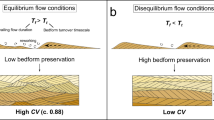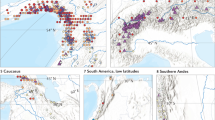Abstract
The Earth’s sedimentary successions are an archive of past tectonic and climate events1,2. The physical characteristics of the sediment record are controlled by three main factors: the sediment supply from the eroding source region, the grain size distribution of that sediment supply, and the area available for sediment accumulation in the downstream regions3,4. The interplay of these factors can make the interpretation of a climatic or tectonic signal complex, particularly as these processes are nonlinear. Here we assess the evolution of a tectonically active landscape undergoing erosional and depositional processes, using a numerical model that incorporates variations in grain size and the volumetric sediment budget. Our simulations indicate that changes in precipitation and tectonic uplift both generate characteristic patterns of grain size and stratigraphic geometry. An increase in catchment precipitation results in the deposition of a laterally extensive sheet of coarse gravel. The responses to a changing tectonic regime are more diverse: a large increase in uplift rate results first in the deposition of sediments of larger grain size at proximal sites, followed by a reduction in grain size at distal locations. We conclude that the stratigraphic record is strongly controlled by the grain size of sediments released from catchments undergoing tectonic or climatic change.
This is a preview of subscription content, access via your institution
Access options
Subscribe to this journal
Receive 12 print issues and online access
$259.00 per year
only $21.58 per issue
Buy this article
- Purchase on Springer Link
- Instant access to full article PDF
Prices may be subject to local taxes which are calculated during checkout




Similar content being viewed by others
References
Zhang, P. Z., Molnar, P. & Downs, W. R. Increased sedimentation rates and grain sizes 2–4 Myr ago due to the influence of climate change on erosion rates. Nature 410, 891–897 (2001).
Duller, R. A. et al. From grain size to tectonics. J. Geophys. Res. 115, F03022 (2010).
Flemings, P. B. & Jordan, T. E. A synthetic stratigraphic model of Foreland basin development. J. Geophys. Res. 94, 3851–3866 (1989).
Paola, C., Heller, P. & Angevine, C. The large-scale dynamics of grainsize variation in alluvial basins: 1. Theory. Basin Res. 4, 73–90 (1992).
Braun, J. in Anologue and Numerical Modelling of Crustal-Scale Processes Vol. 253 (eds Buiter, S. J. H. & Schreurs, G.) 307–325 (Geological Society, Special Publications, 2006).
Humphrey, N. F. & Heller, P. L. Natural oscillations in coupled geomorphic systems—an alternative origin for cyclic sedimentation. Geology 23, 499–502 (1995).
Clevis, Q., d Boer, P. & Wachter, M. Numerical modelling of drainage basin evolution and three-dimensional alluvial fan stratigraphy. Sedim. Geol. 163, 85–110 (2003).
Montgomery, D. R. & Stolar, D. B. Reconsidering Himalayan river anticlines. Geomorphology 82, 4–15 (2006).
Whittaker, A. C. et al. Contrasting transient and steady-state rivers crossing active normal faults: New field observations from the Central Apennines, Italy. Basin Res. 19, 529–556 (2007).
Cowie, P. A. et al. New constraints on sediment-flux-dependent river incision: Implications for extracting tectonic signals from river profiles. Geology 36, 535–538 (2008).
Allen, P. A. in Landscape Evolution: Denudation, Climate and Tectonics Over Different Time and Space Scales Vol. 269 (eds Gallacher, K., Jones, K. S. J. & Wainwright, J.) 7–28 (Geological Society, Special Publications, 2008).
Horton, B. K., Constenius, K. N. & DeCelles, P. G. Tectonic control on coarse grained foreland-basin sequences: An example from the Cordilleran foreland basin, Utah. Geology 32, 637–640 (2004).
Smith, T. R. & Bretherton, F. Stability and conservation of mass in drainage basin evolution. Wat. Resour. Res. 8, 1506–1529 (1972).
Simpson, G. & Schlunegger, F. Topographic evolution and morphology of surfaces evolving in response to coupled fluvial and hillslope sediment transport. J. Geophys. Res. 108, B62300 (2003).
Densmore, A. L., Allen, P. A. & Simpson, G. Development and response of a coupled catchment fan system under changing tectonic and climatic forcing. J. Geophys. Res. 112, F01002 (2007).
Fedele, J. J. & Paola, C. Similarity solutions for fluvial sediment fining by selective deposition. J. Geophys. Res. 112, F02038 (2007).
Wiberg, P. L. & Smith, J. D. Calculations of the critical shear–stress for motion of uniform and heterogeneous sediments. Wat. Resour. Res. 23, 1471–1480 (1987).
Attal, M. et al. Modelling fluvial incision and transient landscape evolution: Influence of dynamic channel adjustment. J. Geophys. Res. 113, F03013 (2008).
Whittaker, A. C., Attal, M. & Allen, P. A. Characterising the origin, nature and fate of sediment exported from catchments perturbed by active tectonics. Basin Res. 22, 809–828 (2010).
Heller, P. L. & Paola, C. The large-scale dynamics of grain size variation in alluvial basins, 2: Application to syntectonic conglomerate. Basin Res. 4, 91–102 (1992).
Lindsay, E. H. et al. Sediments, geomorphology, magnetostratigraphy and vertebrate paleontology in the San Pedro Valley, Arizona. J. Geol. 98, 605–619 (1990).
Schmitz, B. & Pujalte, V. Abrupt increase in seasonal extreme precipitation at the Paleocene–Eocene boundary. Geology 35, 215–218 (2007).
Dühnforth, M. et al. Controls on sediment evacuation from glacially modified and unmodified catchments in the eastern Sierra Nevada, California. Earth Surf. Proc. Land. 33, 1602–1613 (2008).
Pepin, E., Carretier, S. & Herail, G. Erosion dynamics modelling in a coupled catchment–fan system with constant external forcing. Geomorphology 122, 78–90 (2010).
Cavinato, G. P. et al. Sedimentary and tectonic evolution of Plio-Pleistocene alluvial and lacustrine deposits of Fucino Basin (central Italy). Sedim. Geol. 148, 29–59 (2002).
Roberts, G. P. et al. Fault scaling relationships, deformation rates and seismic hazards: An example from the Lazio-Abruzzo Apennines, central Italy. J. Struct. Geol. 26, 377–398 (2004).
Anders, M. H. et al. The growth of fault-bounded tilt blocks. Tectonics 12, 1451–1459 (1993).
Zienkiewicz, O. C. & Taylor, R. L. The Finite Element Method Vol. 1. (Butterworth-Heinemann, 2000).
Bull, W. B. Geomorphology of Segmented Alluvial Fans in Western Fresno County, California (Prof. Paper, US Geological Survey, 1964).
Paola, C. & Seal, R. Grain size patchiness as a cause of selective deposition and downstream fining. Wat. Resour. Res. 31, 1395–1407 (1995).
Acknowledgements
The numerical model was developed through collaborations with G. Simpson (Université de Geneve) and A. Densmore (University of Durham), and with the help of H.M. Nick (Utrecht University). We would also like to thank H. M. Bjornseth and I. Lunt (Statoil) for their constructive input on this work. This work was funded by Statoil through a generic research programme on sediment routing systems.
Author information
Authors and Affiliations
Contributions
J.J.A. designed and carried out the numerical experiments. All authors contributed equally to the analysis of the results and writing of the manuscript.
Corresponding author
Ethics declarations
Competing interests
The authors declare no competing financial interests.
Supplementary information
Supplementary Information
Supplementary Information (PDF 326 kb)
Rights and permissions
About this article
Cite this article
Armitage, J., Duller, R., Whittaker, A. et al. Transformation of tectonic and climatic signals from source to sedimentary archive. Nature Geosci 4, 231–235 (2011). https://doi.org/10.1038/ngeo1087
Received:
Accepted:
Published:
Issue Date:
DOI: https://doi.org/10.1038/ngeo1087
This article is cited by
-
Water discharge variations control fluvial stratigraphic architecture in the Middle Eocene Escanilla formation, Spain
Scientific Reports (2023)
-
Floodplain evolution during the early Paleogene within the Piceance Creek Basin, northwest Colorado, U.S.A
Journal of Sedimentary Environments (2022)
-
Badland landscape response to individual geomorphic events
Nature Communications (2021)
-
Influence of sedimentation rate on the environmental capacity of total nitrogen in the water of Bohai Bay, China
Journal of Soils and Sediments (2021)
-
Tectonic setting and isotopic sources (Sm–Nd) of the SW Iberian Autochthon (Variscan Orogen)
Journal of Iberian Geology (2021)



